All Images
Research News
Quenching the world's water and energy crises, one tiny droplet at a time
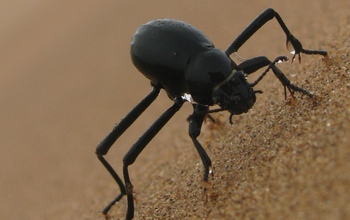
A beetle in the Namib Desert of Africa uses its textured back to gather drinking water from the fog-filled morning wind. If researchers can perform some beetle biomimicry, that would mean a new source for water in dry areas.
Credit: James Anderson (Creative Commons BY-NC-SA 2.0)
Download the high-resolution JPG version of the image. (1.8 MB)
Use your mouse to right-click (Mac users may need to Ctrl-click) the link above and choose the option that will save the file or target to your computer.
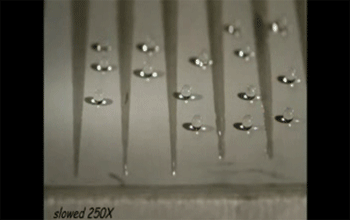
Superhydrophobic materials have micro- or nano-sized pillars, poles or other structures that alter the angles at which water droplets contact their surface. These contact angles determine whether a water droplet beads up like a teeny crystal ball or relaxes a bit and rests on the surface like a spilled milkshake. By varying the layout of these surfaces, researchers can trap, direct and repulse small amounts of water for a variety of new purposes.
Credit: Constantine M. Megaridis, Aritra Ghosh, Ranjan Ganguly, Mechanical and Industrial Engineering, University of Illinois at Chicago
Download the high-resolution GIF version of the image. (726.5 KB)
Use your mouse to right-click (Mac users may need to Ctrl-click) the link above and choose the option that will save the file or target to your computer.
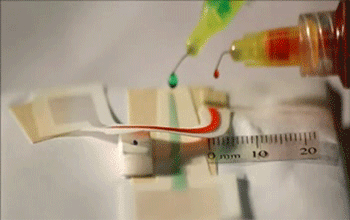
Plastic strips with superhydrophilic centers and superhydrophobic surroundings that combine or separate fluids have the potential to serve as platforms for diagnostic tests. Just like a highway, the road is the strip for the liquid to travel down, and it ends up collecting in a fluid storage tank on the surface. The storage tank could hold a reactive agent. Medical personnel could use the disposable strips to field-test water samples for E. coli, for example.
Credit: Constantine M. Megaridis, Aritra Ghosh, Ranjan Ganguly, Mechanical and Industrial Engineering, University of Illinois at Chicago
Download the high-resolution GIF version of the image. (673.7 KB)
Use your mouse to right-click (Mac users may need to Ctrl-click) the link above and choose the option that will save the file or target to your computer.
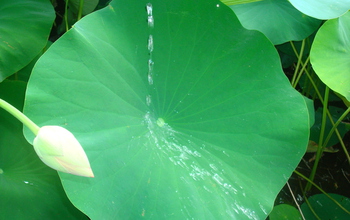
Engineers look to nature to learn how to reduce the time it takes for a water droplet to bounce away from a surface. Lotus leaves, once considered the gold standard of superhydrophobic materials, are naturally water-repellant due to the tiny bumps on their surface.
Photo taken at Meadowlark Botanical Gardens, Vienna, Va.
Credit: Paloma E. Gonzalez
Download the high-resolution JPG version of the image. (2.2 MB)
Use your mouse to right-click (Mac users may need to Ctrl-click) the link above and choose the option that will save the file or target to your computer.

Superhydrophobic coatings speed up the rate at which water vapor can condense on a surface. Condensers are everywhere. They are in your refrigerator, car and air conditioner. More efficient condensation would allow this equipment to function with less energy. Better efficiency is especially important in places where large-scale cooling is paramount, such as power plants.
Credit: Constantine M. Megaridis, Aritra Ghosh, Ranjan Ganguly, Mechanical and Industrial Engineering, University of Illinois at Chicago
Download the high-resolution GIF version of the image. (1.1 MB)
Use your mouse to right-click (Mac users may need to Ctrl-click) the link above and choose the option that will save the file or target to your computer.
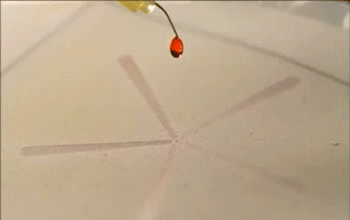
As superhydrophobic materials become cheaper, their potential as disposable medical devices grows. Tiny amounts of fluid, such as saliva or blood, can be mixed and measured on a paper strip, and then tossed.
Credit: Aritra Ghosh, Ranjan Ganguly, Thomas M. Schutzius, Constantine M. Megaridis, "Wettability patterning for high-rate, pumpless fluid transport on open, non-planar microfluidic platforms," Lab Chip 14, 1538-1550 (2014) -- Reproduced by permission of The Royal Society of Chemistry.
Download the high-resolution GIF version of the image. (996.6 KB)
Use your mouse to right-click (Mac users may need to Ctrl-click) the link above and choose the option that will save the file or target to your computer.
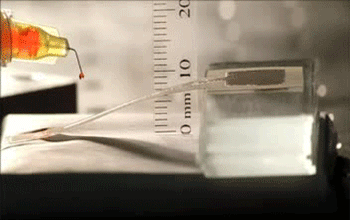
At the microscale, who needs a pump? Surface tension causes liquids to travel uphill on the path of least resistance.
Credit: Aritra Ghosh, Ranjan Ganguly, Thomas M. Schutzius, Constantine M. Megaridis, "Wettability patterning for high-rate, pumpless fluid transport on open, non-planar microfluidic platforms," Lab Chip 14, 1538-1550 (2014) -- Reproduced by permission of The Royal Society of Chemistry.
Download the high-resolution GIF version of the image. (976.3 KB)
Use your mouse to right-click (Mac users may need to Ctrl-click) the link above and choose the option that will save the file or target to your computer.

Engineers are looking to nature to learn how to reduce the time it takes for a water droplet to bounce away from a surface. The less time water spends in contact with a cold surface, like an airplane wing, the less likely it is to freeze and ice over.
Credit: James C. Bird, Rajeev Dhiman, Hyuk-Min Kwon and Kripa K. Varanasi
Download the high-resolution GIF version of the image. (684.3 KB)
Use your mouse to right-click (Mac users may need to Ctrl-click) the link above and choose the option that will save the file or target to your computer.

Less contact time also means less opportunity for water or toxins within the water to degrade or dirty surfaces. This could mean longer-lasting roofs and solar panels.
Credit: James C. Bird, Rajeev Dhiman, Hyuk-Min Kwon and Kripa K. Varanasi
Download the high-resolution GIF version of the image. (375.6 KB)
Use your mouse to right-click (Mac users may need to Ctrl-click) the link above and choose the option that will save the file or target to your computer.

Understanding how liquids interact with different materials can lead to more efficient, inexpensive processes and products, and might even lead to airplane wings impervious to ice and self-cleaning windows.
Credit: Aritra Ghosh, Ranjan Ganguly, Thomas M. Schutzius, Constantine M. Megaridis, "Wettability patterning for high-rate, pumpless fluid transport on open, non-planar microfluidic platforms," Lab Chip 14, 1538-1550 (2014) -- Reproduced by permission of The Royal Society of Chemistry.
Download the high-resolution GIF version of the image. (229.2 KB)
Use your mouse to right-click (Mac users may need to Ctrl-click) the link above and choose the option that will save the file or target to your computer.
Engineers can now create materials that repel liquids so well they're called superhydrophobic (i.e. they have a serious water phobia). With funding from NSF, this booming area of research has the potential to benefit society in a big way.
Credit: NSF
Download the high-resolution JPG version of the image. (60.3 KB)
Use your mouse to right-click (Mac users may need to Ctrl-click) the link above and choose the option that will save the file or target to your computer.


